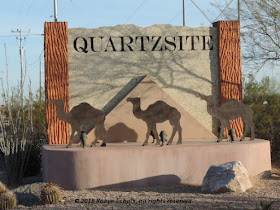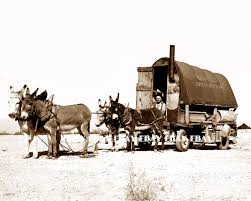The
town of Quartzsite is located on the site of old Fort Tyson, a privately owned
fort built in 1856 by Charles Tyson for protection against Indians. Because of
the water which existed at this place, Tyson's Wells soon became a stage
station on the road from Ehrenburg to Prescott. In 1875 Martha Summerhayes
described this place as being the most melancholy and uninviting that she had
ever seen, saying that it "reeks of everything unclean, morally and
physically..."
Charles
Tyson was an early settler who saw the mining potential of the region in the La
Posa Valley. In the early years of the American gold rush, pan handlers began
to arrive in Arizona searching for the precious metal. Gold deposits were
discovered in the desert mountains of Plomosa and Dome Rock in the area and a
boom in the mining industry followed. The key was water. The water supply in
the area became the target of the Yavapai tribe (a.k.a. Mohave-Apache) who resented
the arrival of the Anglo-European settlers on their land and raided the early
settlements.
The
settlement was also known as Tyson’s Wells, because of the well dug there in
1864 to reach the underground water.
Tyson
then built a stage station in 1866, which originally served the stage coaches
that traveled from the towns of Ehrenberg and Prescott. Prescott at the time
was the capital city of the Arizona Territory. The California and Arizona Stage
Company began transporting passengers which included prospectors, since gold
had been discovered in the mines of Wickenburg and Prescott, and made stops at
the station. The Wells Fargo Express also stopped by the station en route to
Ehrenberg and Wickenburg from California. Tyson’s Well Stage Station was
located on the famous Butterfield Overland Mail route between Prescott, Arizona
and Riverside, California.
When
the railroad came, most stagecoach travel ended, leading to a major slump for Tyson’s
Wells.
In
1897, the development of mining in the area resulted in a small boom. It was
reported that Tyson's Wells had three stores, two saloons, and a short-lived
post office. Apparently when it became necessary to re-open the post office
because of renewed mining activity, a new name had to be found since the post
office did not permit offices to re-open the post office under formerly used
names. Therefore, George Ingersoll suggested the name Quartzite, since quartzite
is actually found in the vicinity, but quartz is not. However, the post office
in error apparently added an "s" to the name. The resulting
"Quartzsite" erroneously implies that quartz is found locally.
Actually Quartzsite is approximately nine miles east of the old Tyson's Wells
which lay nineteen miles from Ehrenberg. Therefore, a different name was a better
suited.
Quartzsite also became associated with the camels that were turned loose in the region about the time of the Civil War after the U.S. Army abandoned their camel program. Many lived in the La Posa Valley for years.
Sources:
Wikipedia
http://www.ghosttownaz.info/old-fort-tyson.php
My Independence Day 1881 –
Zina Abbott’s Sweethearts of Jubilee Springs is available both as an ebook and in print on
Amazon. If you have a Kindle Unlimited account and have not yet read all three
of my first three books, this book containing three novellas will count as one
book on your KU queue. You may find the book description and purchase link by CLICKING HERE.
After you finished reading this book, please
leave a review on Amazon and Goodreads.
























